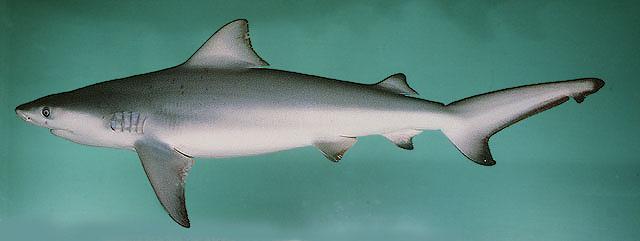| Carcharhinidae (Requiem sharks) |
| 360 cm TL (male/unsexed); 400 cm TL (female); max.weight: 317 kg; max. reported age: 32 years |
|
reef-associated; freshwater; brackish; marine; depth range 1 - 164 m, amphidromous |
| Cosmopolitan in tropical and subtropical waters (Ref. 81283): widespread in warm oceans, rivers and lakes (Ref. 4716). Western Atlantic: Massachusetts, USA to Argentina (Ref. 58839); eastern Atlantic: Morocco, Senegal to Angola (Ref. 81283, 81623); Indo-Pacific: Kenya and South Africa to India, then, Viet Nam to Australia; southern Baja California, Mexico to Ecuador and possibly occurring in Peru. Africa: in freshwater found in rivers of West Africa from Gambia River to Ogowe River (Ref. 81283) and in the Cuanza in Angola (Ref. 120641).
Sympatric with Carcharhinus amboinensis, Glyphis gangeticus. |
|
Dorsal spines (total): 0-0; Dorsal soft rays (total): 0-0; Anal spines: 0-0; Anal soft rays: 0-0. Diagnosis: Carcharhinus leucas is a massive shark with a short, broad and blunt snout, small eyes and triangular saw-edged upper teeth, and lack of interdorsal ridge, characters which are sufficient to distinguish this species (Ref. 26938).
Description: A large carcharhinid characterized by its massive body, a very short and rounded snout and tiny, round eyes (Ref. 81283, 81623). Labial folds rudimentary, nasal flap broadly triangular (Ref. 81623). Teeth in the upper jaw are upright, strongly serrated, triangular and broad at their bases, with strongly denticulate edges; teeth in the lower jaw are more slender and pointed, their edges finely denticulate (Ref. 12484, 81283, 81623). Symphysial teeth present on both jaws; tooth formula 12-14/12-13 on each side of jaws (Ref. 81623). Spiracles absent, posterior lateral gill-slits overlapping origin of pectoral fins (Ref. 81623). First dorsal fin broad and triangular, slightly convex anteriorly but with a concave posterior margin; distinctly smaller than the second, less than 3.2 times height of second dorsal fin; beginning slightly before anal-fin origin; no interdorsal ridge (Ref. 5578, 81253, 81283, 81623). Second dorsal fin much smaller than first, situated over anal fin (Ref. 81623). Pectoral fins rather large and broad (Ref. 81623). Posterior margin of anal fin strongly concave (Ref. 81623). Precaudal vertebral centra 101-103, total vertebral centra 198-227 (Ref. 81623).
Colouration: The colour of the body is predominantly grey with a pale to white underside (Ref. 5578, 12484, 81623). Juveniles have black tips to their fins, which fade with age (Ref. 9997, 12484). |
| A coastal and freshwater shark inhabiting shallow waters especially in bays, estuaries, rivers, and lakes (Ref. 244). It readily penetrates far up rivers and hypersaline bays and littoral lagoons (Ref. 9997, 44894, 81283). Capable of covering great distances (up to 180 kilometers in 24 hours), moving between fresh and brackish water at random (Ref. 44894). Adults often found near estuaries and freshwater inflows to the sea; young enter rivers and may be found hundreds of km from the sea (Ref. 4967, 44894, 58304). Feeds on bony fishes, other sharks, rays, mantis shrimps, crabs, squid, sea snails, sea urchins, mammalian carrion, sea turtles, and occasionally garbage (Ref. 244, 5578, 44894). Viviparous (Ref. 50449). Gives birth to litters of up to 13 young (Ref. 26938, 44894). Size at birth is 56-81 cm TL (Ref. 81623). Sexual maturity is attained after 10-15 years (at a length between 160-200 centimeters) (Ref. 44894). Though not commercially important, this species is a good food fish (Ref. 12484). Utilized fresh, fresh-frozen or smoked for human consumption, fins for soup, hide for leather, liver for oil, and carcass for fishmeal (Ref. 244). Very hardy and lives well in captivity (Ref. 244). This large shark is potentially dangerous to man (Ref. 81283), probably the most dangerous species of tropical shark (Ref. 244), and it is repeatedly implicated in attacks on humans (Ref. 4967, 44894); attacks in fresh water are rare (Ref. 44894). |
|
Vulnerable (VU); Date assessed: 24 November 2020 (A2bcd) Ref. (130435)
|
| traumatogenic |
Source and more info: www.fishbase.org. For personal, classroom, and other internal use only. Not for publication.

